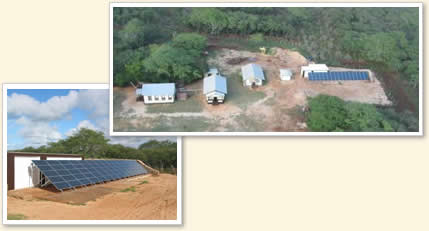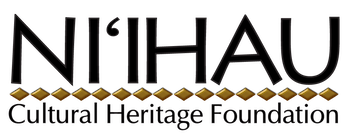Ni‘ihau Today
It’s the absence of certain things on Ni‘ihau that seems to be an enduring aspect of life on the Forbidden Island. There are no paved roads. No cars. No stores. No restaurants. No doctors. No police. No fire department. And no indoor plumbing.
The Only School in Hawai‘i that Relies Entirely on Solar Power
On the other hand, Ni‘ihau has the only school in Hawai‘i—and perhaps the only one in the country—that relies entirely on solar power for its electricity, thanks to a 10.4 kW photovoltaic power system with battery storage installed at Ni‘ihau School in December 2007.

This allows Ni‘ihau students to become computer literate even in such an isolated place that seems, in many ways, far removed from the twenty-first century. In spite of such tentative steps into the modern world, however, the full-time population of the island continues to decline.
Ranching Provided Employment for Ni‘ihau Residents until 1999
Since the forebears of the current owners purchased the island in 1864, there had always been full-time employment for the residents with Ni‘ihau Ranch. However, it was finally acknowledged that it was impossible to make a profit from cattle ranching, sheep ranching, making kiawe charcoal, or processing honey on the island. So when the Ranch was closed on Ni‘ihau in 1999, full-time employment on the island—except for a few positions at Ni‘ihau School—essentially became a thing of the past for most of the population.
Today, in addition to the limited openings at the school, Ni‘ihau Safaris, Ltd., and support for a small US Navy installation provide the only employment available to a small number of workers, and neither of the latter offers full-time work for the residents. Making and selling Ni‘ihau shell lei is, therefore, not only important as the preservation of a unique element of Ni‘ihau culture, but also as an essential source of income for Ni‘ihau families.
So without a sound economic base on the island, how many residents can Ni‘ihau realistically support?
A Declining Population Due to Lack of Employment
A recent informal population count indicated that the number of individuals who actually lived on the island for any meaningful length of time during the school year was no more than 70, and the total at any particular time was ordinarily less than this number, often significantly lower. The resident population also sometimes drops to less than 30 during the summer months when school is on vacation and families travel to Kaua‘i to spend time with relatives there.
While it’s true that a larger number of Ni‘ihau people do still consider the island to be their home, lack of economic opportunities, health issues, and more homesites becoming available on Kaua‘i through the Department of Hawaiian Home Lands are all contributing factors that have resulted in more families spending a greater amount of time on Kaua‘i or even moving away from Ni‘ihau permanently.
Many may dream of returning to their home island someday, but at present this dream is not having any significant impact on the size of the full-time population. Perhaps innovative economic development that will not significantly alter the environment or lifestyle of the island will one day make it more feasible for some of these families to fulfill their dream and return to the island.
In the meantime, however, there are certain inevitable results of this emigration of the Ni‘ihau population. One is that as more and more families leave the island, fewer children in the community are being raised as fluent speakers of the Ni‘ihau dialect. See the section on LANGUAGE & DIALECT to learn more about this subject.
Another result is that the number of lei makers who have family remaining on the island that can gather the shells needed to make Ni‘ihau shell jewelry is limited. Because of this, there are skilled artisans living on Kaua‘i who are unable to practice their craft simply because they do not have the shells to do so.
Therefore, with the decrease in accessibility to shells and the distractions of living in the “modern world” available on Kaua‘i, the skill of making Ni‘ihau shell lei is being passed down to fewer and fewer members of the next generation, particularly among those who now live full time away from the home island.
Yet today the art of making Ni‘ihau shell lei is still alive. In fact, in some circles it may even be thriving as more people become aware of this fine folk art that has been handed down through countless generations of Hawaiians living on the Forbidden Island of Ni‘ihau. Nevertheless, the long-term future of the exquisite Ni‘ihau shell lei is anything but asssured.
About the Island of Ni‘ihau
Ni‘ihau is the smallest inhabited island in Hawai‘i but nearly twice as large as uninhabited Kaho‘olawe. It is roughly 18 miles long and from 3 to 6 miles wide with a total area of approximately 70 square miles. The elevation of Pānī‘au, its highest peak, is only 1280 feet, which—along with being in the rain shadow of neighboring Kaua‘i—explains the arid climate of the island.
Livestock & Exotic Animals Roam Freely
Much of the island is covered with kiawe trees (a species of mesquite) planted by the grandfather of the current owners. Roaming freely among the kiawe and across the island are not only pigs, sheep, and cattle, but also more exotic animals such as herds of eland and aoudad as well as some oryx. These animals were brought to Ni‘ihau from Moloka‘i Ranch when its wildlife park closed in 1999, and at least the eland and aoudad seem to be thriving in their new home.
Home to the Largest Lake in Hawai‘i
Lake Hālāli‘i is considered the largest lake in Hawai‘i with 841+ acres while nearby Lake Halulu is 182+ acres, but these are sometimes called “playa” or “intermittent lakes.” This is because the water comes from rainfall, which only averages between 20 to 40 inches per year on Ni‘ihau. During dry years, the lakes are also dry. There are no streams on the island.

Pu‘uwai village:
The Population Center of Ni‘ihau
Pu‘uwai village, on the western or leeward side of the island, is the population center of Ni‘ihau, and although there are historical maps and other documents that identify Pu‘uwai and numerous other names for places throughout the island, most of these names have been lost to the memory of the current generation, especially the young people. Among place names still in common use, however, are those of the beaches where Ni‘ihau shells are gathered.
Just across a narrow channel from Nanina beach on the northern tip of the island lies Lehua, a volcanic tuff cone that figures prominently in traditional Hawaiian literature as the place where the sun sets.




































